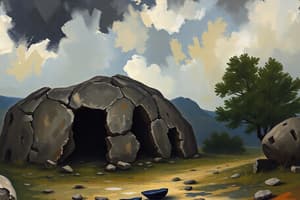Podcast
Questions and Answers
What defines the Stone Age?
What defines the Stone Age?
The Stone Age is a prehistoric period where people primarily made tools from stone.
Why is the Stone Age considered prehistoric?
Why is the Stone Age considered prehistoric?
It is considered prehistoric because there are no written records from that time.
How did Stone Age people create tools from stone?
How did Stone Age people create tools from stone?
They hit stones against each other to break off sharp pieces.
What materials besides stone did people in the Stone Age use?
What materials besides stone did people in the Stone Age use?
What was the primary focus of Stone Age people's survival?
What was the primary focus of Stone Age people's survival?
What types of food did Stone Age people typically eat?
What types of food did Stone Age people typically eat?
Why did Stone Age people likely live in groups?
Why did Stone Age people likely live in groups?
What was an important tool for gathering food in the Stone Age?
What was an important tool for gathering food in the Stone Age?
What advancement ended the Stone Age?
What advancement ended the Stone Age?
What types of animals did Stone Age people hunt during the Ice Age?
What types of animals did Stone Age people hunt during the Ice Age?
How did Stone Age people use the animals they hunted?
How did Stone Age people use the animals they hunted?
Where did Stone Age people typically find shelter?
Where did Stone Age people typically find shelter?
What did the climate changes during the Stone Age influence?
What did the climate changes during the Stone Age influence?
What role did fire play in the lives of Stone Age people?
What role did fire play in the lives of Stone Age people?
What term describes the lifestyle of Stone Age people as they moved in search of food?
What term describes the lifestyle of Stone Age people as they moved in search of food?
What did shelter typically look like in warmer parts of the world during the Stone Age?
What did shelter typically look like in warmer parts of the world during the Stone Age?
How did the end of the Ice Age affect the availability of animals for hunting?
How did the end of the Ice Age affect the availability of animals for hunting?
What essential need did Stone Age people fulfill by gathering plants?
What essential need did Stone Age people fulfill by gathering plants?
In what way did nomadic living influence the Stone Age diet?
In what way did nomadic living influence the Stone Age diet?
Flashcards are hidden until you start studying
Study Notes
Overview of the Stone Age
- Prehistoric period where humans created all necessary tools and items from available materials, primarily stone.
- Marked the transition to the use of metal tools, signaling the end of the Stone Age.
- No written records exist from this time, defined as the period before the advent of writing.
Tool Making
- Stone was the primary material used for tool-making; various types of stone were utilized.
- Techniques involved striking stones together to produce sharp-edged pieces.
- Tools evolved over time to include smaller objects like arrowheads, alongside larger tools such as axes and knives.
- Other materials such as animal skins and bones were also important; skins were used for clothing and shelters, while bones were repurposed as hammers.
Diet and Food Sources
- Survival depended on the ability to secure enough food; hunting and gathering were crucial activities.
- Diet consisted of meat from hunted animals, fish from nearby water sources, and a variety of gathered plants including fruits, nuts, berries, green plants, roots, and wild grains.
- People are classified as hunter-gatherers due to their reliance on hunting and foraging for sustenance.
Social Structure
- Collaboration was essential; hunting large animals often required group effort for success.
- Living in groups facilitated not only hunting but also the gathering of plant food, suggesting social cooperation was common among Stone Age people.
Hunting and Food Sources
- Stone Age people hunted animals depending on their environment and time period.
- Ice Age megafauna included woolly mammoths, woolly rhinoceroses, cave bears, and sabre-toothed tigers.
- After the Ice Age, smaller animals like wolves, bears, deer, and wild cattle became prevalent.
- Availability of plants varied with climate, affecting the diet of early humans.
Lifestyle and Movement
- Nomads followed animal migrations for hunting and sought areas with food resources.
- Hunter-gatherers required warm and dry shelters for safety and comfort.
- Movement to warmer regions was essential for survival during colder climates.
Shelter Construction
- Caves were used as shelters in colder areas, providing warmth and protection.
- In warmer regions, people constructed temporary shelters with wooden or bone frames covered by animal skins, resembling tents.
Importance of Fire
- Fire was crucial for warmth, cooking meat, and deterring wild animals.
- Small wood fires were maintained near cave entrances or outside shelters, enhancing safety and comfort.
Glossary Terms
- Ice Age: A period characterized by significant glacial coverage and lower global temperatures.
- Nomads: People who move frequently in search of food and shelter, rather than settling in one place.
- Shelter: Structures or natural formations that provide protection from the elements.
Studying That Suits You
Use AI to generate personalized quizzes and flashcards to suit your learning preferences.




